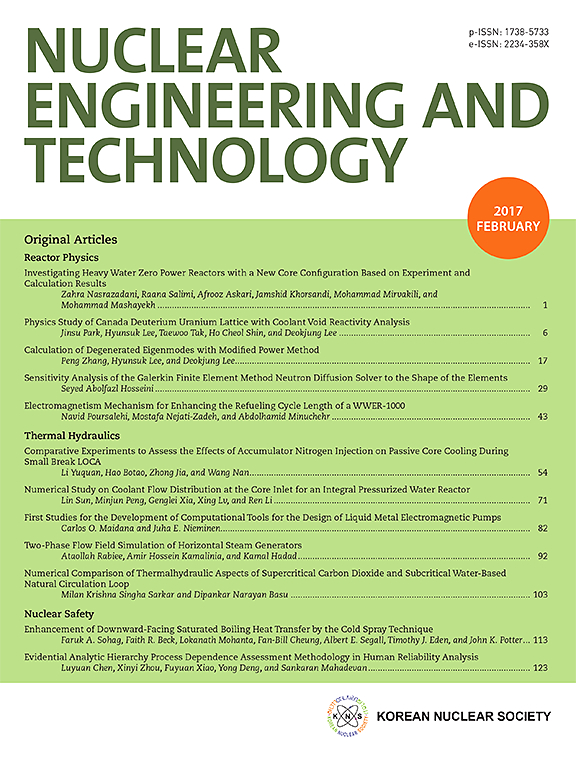Radiological safety of workers for the beta-nuclide removal treatment of the mixed waste from Wolsong nuclear power plant
IF 2.6
3区 工程技术
Q1 NUCLEAR SCIENCE & TECHNOLOGY
引用次数: 0
Abstract
This study evaluates the radiological safety of the beta-nuclide removal process for mixed radioactive waste (waste resin, activated carbon, and zeolite) generated during the operation of Wolsong Unit 1. In addition, the potential for reducing worker radiation exposure in accident scenarios was investigated to optimize waste processing capacity. Using the VISIPLAN dose assessment code, external exposure was analyzed in scenarios involving the leakage of airborne radioactive particulates during the beta nuclide removal process. Internal exposure was assessed by taking into account the concentration of airborne radioactive particulates and effectiveness of the protective equipment. The 1 kW beta-nuclide removal reactor processes activated carbon and zeolite, while the 9 kW beta-nuclide removal reactor processes waste resin. Under the conditions of airborne radioactive particulates leakage, the maximum total dose rates for the 1 and 9 kW beta nuclide removal reactors reached 1.51 × 10−2 and 7.22 × 10−2 mSv/h, respectively. Based on the annual dose limit of 20 mSv over a five-year period, the permissible operating hours for the 1 kW and 9 kW reactors were determined to be 1325 h and 277 h, respectively. It is expected that these results will contribute to advances in radiation safety assessment techniques for reactor decommissioning and radioactive waste management.
月松核电站混合废物β -核素去除处理工人的放射安全
本研究对月松1号机组运行过程中产生的混合放射性废物(废树脂、活性炭、沸石)进行了β -核素去除工艺的放射安全性评价。此外,还研究了在事故情况下减少工人辐射暴露的可能性,以优化废物处理能力。使用VISIPLAN剂量评估代码,分析了在去除β核素过程中涉及空气中放射性微粒泄漏的情况下的外部照射。通过考虑空气中放射性微粒的浓度和防护设备的有效性来评估内部照射。1 kW的β -核素去除反应器处理活性炭和沸石,而9 kW的β -核素去除反应器处理废树脂。在大气放射性粒子泄漏条件下,1 kW和9 kW核素去除反应堆的最大总剂量率分别达到1.51 × 10−2和7.22 × 10−2 mSv/h。根据5年期间20毫西弗的年剂量限值,确定1千瓦和9千瓦反应堆的允许运行时间分别为1325小时和277小时。预期这些结果将有助于在反应堆退役和放射性废物管理的辐射安全评估技术方面取得进展。
本文章由计算机程序翻译,如有差异,请以英文原文为准。
求助全文
约1分钟内获得全文
求助全文
来源期刊

Nuclear Engineering and Technology
工程技术-核科学技术
CiteScore
4.80
自引率
7.40%
发文量
431
审稿时长
3.5 months
期刊介绍:
Nuclear Engineering and Technology (NET), an international journal of the Korean Nuclear Society (KNS), publishes peer-reviewed papers on original research, ideas and developments in all areas of the field of nuclear science and technology. NET bimonthly publishes original articles, reviews, and technical notes. The journal is listed in the Science Citation Index Expanded (SCIE) of Thomson Reuters.
NET covers all fields for peaceful utilization of nuclear energy and radiation as follows:
1) Reactor Physics
2) Thermal Hydraulics
3) Nuclear Safety
4) Nuclear I&C
5) Nuclear Physics, Fusion, and Laser Technology
6) Nuclear Fuel Cycle and Radioactive Waste Management
7) Nuclear Fuel and Reactor Materials
8) Radiation Application
9) Radiation Protection
10) Nuclear Structural Analysis and Plant Management & Maintenance
11) Nuclear Policy, Economics, and Human Resource Development
 求助内容:
求助内容: 应助结果提醒方式:
应助结果提醒方式:


